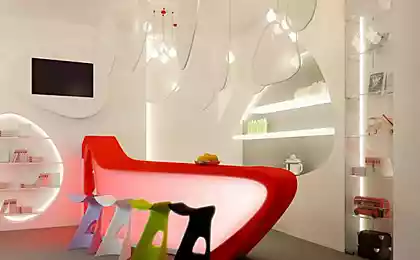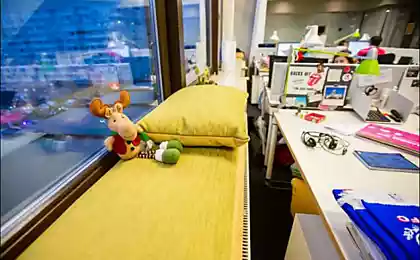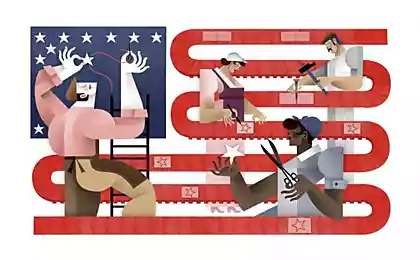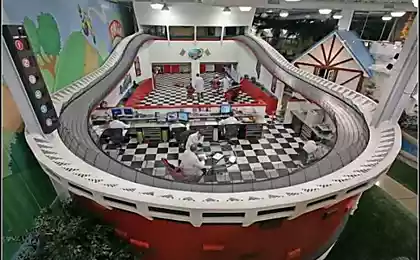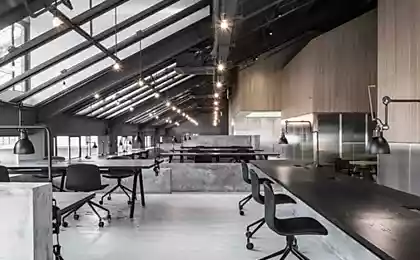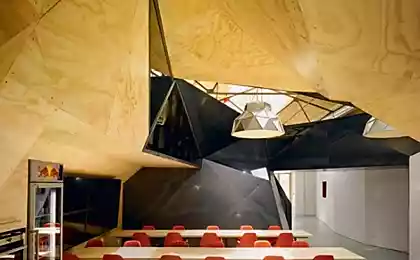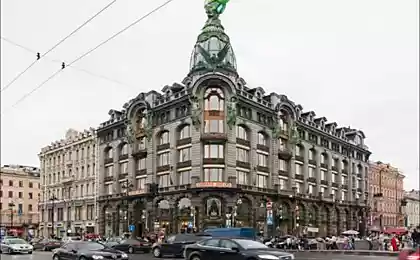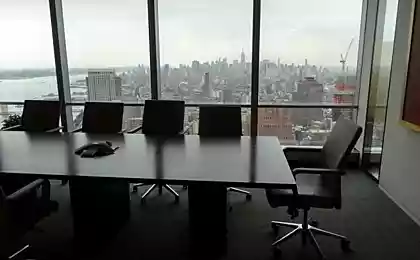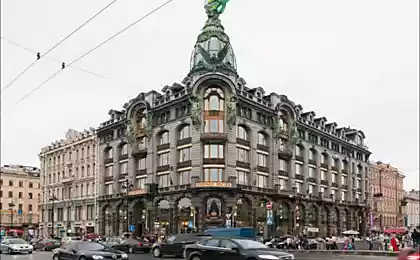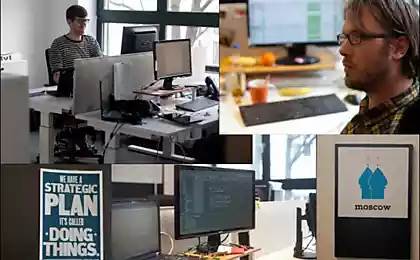The history of evolution Office
What first comes to mind when you hear the word "office"? Probably images: office cabinets, soft chairs, clicking keys, office gossip, the smell of stale coffee and the people are so busy that typing on their computers, they do not even think to smile. So, all of this is in the past ... With the development of new technologies in general, the concept of "office space" has undergone drastic changes. Now startups or freelancer goes to "my office," where everything is arranged for his convenience.
Results исследования Deskmag for 2013 are striking:
- 50% of all employees are working space around the clock
- 71% reported increases in their own creativity after moving
- 62% stated that their working conditions improved
- Nearly 90% of employees reported an increase in self-confidence
- 70% of employees feel healthier than when working in a traditional office
- From the third to a half of all workers are flexible and Mobile
- 64% of the staff stopped to pluck deadlines
Do office work productively mankind has tried since the emergence of offices and continues today. Few people know how exciting and confusing was this way. IMHO the history of the organization of mental work can be divided into two stages. First - from the 18th century to 1900, the second - from the beginning of the twentieth century to the present. Moreover, since the early 20th century to the present day was created only five types of organization of the office.
Just before 1900 office workers around the world was less than 300 000 people, and they were scattered enterprises, markets, exchanges, factories and manufactories. In fact, until the twentieth century, the office was just a desk and a chair.
Generally the first office building in history - East India House in London. Managing colonies grew so that only paperwork required thousands of office clerks. All they had to gather in one place and provide them with ideal working conditions. That's what started the rapid evolution of offices, whose purpose was to create the most free and comfortable space to work.
Studying the history of office, I suddenly discovered that the center and foundation of any office - is an office chair. That thing sitting on which you are reading these lines. The fact is that until the mid-twentieth century was a normal chair ... luxury!
Interior House of India. The Board sits on a chair.
All the same House of India. People clinging easier on the benches.
Thus, the final birth of the world's popular culture was in the 60s. And you know why at this time? Plastics. In the 60s people nashtampovali cheap seats. Anyone could buy a miracle for 9 bucks and fall apart in the pleasure. Before this chair was 5% of people and 20% of the house was not even a chair. Sitting on a stool, and even on the box. Life.
It is because "shtuchnosti" story office chair is very interesting. More Protagoras argued that man - the measure of all things. Consequently, the whole architecture is based on human proportions, and therefore the simplest (but full!) Architectural element - a chair. Not accidentally, each marked by a famous architect in the history of the creation of his chair, and each architectural era can be expressed through this piece of furniture.
Actually, first decided to make the chair "Affordable and functional" English cabinetmaker Thomas Chippendale in 1760. He became the first in history to make cheap chairs design simple. "People's chairs" caused such a sensation that made the author's name a household word. Animated series "Chip and Dale" was named in honor of exactly these chairs.
But you know what caused the massive chairs backlash folklore. Based chipendeylovskogo chair is none other than Voltaire makes great strides forward - the first clue to put a chair on wheels, so as not to wake up every time for the desired paper. Voltaire has attached the board to the right, which rotated and was intended for the letter. On the left is a box in which to store the paper, pen and ink. This design was equally convenient for leisure or for work.
Later, it became known as "armchair Voltaire" - it has been preserved and is now in the Carnavalet Museum (Hôtel Carnavalet) in Paris.
By the late 18th century armchair on wheels was not uncommon, and only later perfected. In this period it became a direct attribute of office. These seats are often included in the package with the bureau or desk. Armchair on wheels made of wood, wicker and were bent. Rarely found in cast iron chairs.
Here's an example study of Charles Darwin. As you can see here on wheels all the furniture. For its time it was as anti-gravity - the future is here and now!
Third inventor towards modern chair is considered the third US president, Thomas Jefferson. Dated this event in 1779 year - then make Jefferson guessed rotating chair.
But the real office chair was born only at the London World Exhibition in 1851.
This chair was the apotheosis of ergonomics and immediately had all the functions of maintaining comfort - can be tilted, rotated and adjusted in height. Now for the office table could spend all day and not get tired.
Surprisingly, the chair has caused a huge outcry from the church - because the chair broke the main commandment of Victorian morality - it lets you work with pleasure, while the Church and Queen advocated humility. Believes that the work on the uncomfortable stool without back - the only way to demonstrate their sophistication and strength of will, and hence their high morale.
But progress was unstoppable. At the same show in 1851 saw the light of the main chair in history, consisting only of bent beech elements serving 30-50 years! Engineering marvel showed the Germans.
Венский chair . The most simple, cheap, durable and comfortable chair in history - make it allowed ingenious technology of bending under steam beech wood. The most important invention of the German people believed him, Otto von Bismarck, velevshy equip these chairs not only Parliament, but all state institutions.
It is easy, elegant, concise! There are only 6 elements. This simplicity was revolutionary. Viennese chair was the first sign in the mass production of cheap goods.
Details are bonded to each screw. Unassembled in a box capacity of 1 cu. m. The fit 36 (!) chairs. It was also a new word in the transportation of goods.
In order to show the strength of the chair №14, it dropped from the Eiffel Tower. The chair remained unharmed!
So Europe and America have chosen different ways of office building, and two chairs have become symbols of the two cultures. Europe showed humility on bentwood chairs, Americans rode on skyscrapers in their office chairs.
Tesla in his lab sits on American classics.
By this time there were two remarkable events in the architecture - Чикагский fire and steel beam. Caught in one place at one time, they gave birth to a new kind of architecture.
In 1871, Chicago burns to ashes. The year before, the steel mills of America are moving to a standard steel beam whose price begins to decline rapidly.
1867 1870 1875 1880 1885 1890 1895 $ 166 $ 107 $ 69 $ 68 td > $ 29 $ 32 $ 24 So is born Chicago school, will shape the next half-century buildings. Now, the building could be built entirely of steel frame - any height, with huge windows and spacious interiors. Steel still remains quite expensive and restrictions applied only as an overlay. Only by 1890 its price has dropped enough to replace the beams both horizontal and vertical supports - building received an all-metal frame. These were the first skyscrapers.
Looked like offices 1880-1930-ies? It's always been spacious rooms with free arrangement, because the sunlight was then the primary means of lighting - designed on this basis and the size and layout. Profitability of office depended on the large windows and high ceilings, allowing sunlight to penetrate as deeply as possible. Distance from the windows to the walls could not exceed 9 meters, which is the limit of penetration of sunlight. Ceilings were 3 to 4 feet high, and the windows, of course, were the largest possible area - at least 2x3 meters. If you had to divide the office - it was used only by clear glass. All this allows both ventilate and dissipate noise
Prior to this office never lies above the second floor, and office buildings themselves could not be above 4-5 floors, as hunters climb the steep stairs was not particularly. Wishing to use the elevator was even less: the fact that their design was deadly - the platform and rope. If the cable was torn (which is inevitable), the platform falls freely into the mine. Only in 1854, Elijah Otis patents the emergency brake for lifts.
Then the inventor amazed public demonstration of its safety devices on display at the Crystal Palace, New York - Otis stood on an open platform lift, while an ax to chop off his assistant hold the rope; while the platform remained in place and does not fall into the pit through the catcher. In 1861, Otis begins production of electric lifts. In 1900 - creates the first escalator.
Equitable Building in 1870 became the first office building with an elevator, de facto, the first skyscraper in front of us. Immediately coined a new type of office - the company took the first two floors, and lease the rest.
Now everything fell on its head. The higher the level, the more expensive the room - it's up there full of light and there is no noise from the street, and panoramic windows giving wonderful views of the city.
An interesting feature of «Флэтайрон-билдинг» 1904 lies in the fact that it was one of the first high-rise buildings, constructions which are mounted on a frame made of steel beams. As you can see, the plot of land was very tiny, and the architect simply was not possible to use a stone or concrete, as thickness of the walls just would not leave space on the ground floor. The building went so high that turned into a wind generator, and men from all over New York came to gawk at the pretty ladies skirt ride up. Hence grow legs famous photograph with developing dress Marilyn Monroe.
Start of the race for the floors. In New York, 30-storey building was built in 1899, the 47 - in 1908, and 60 in 1913. Land prices have not kept you waiting. In the center of Chicago in 1880 one acre was worth $ 130,000, but in 1890 he is already worth $ 900 000.
With the beginning of the twentieth century began rapid industrialization: in every major city in America opened business colleges that train professional clerks. The population of "white collar" beginning to grow at a rate of 286% over the decade, while for other professions growth was on average 65%. Their share rose from 5% in 1900 to 11% in 1920.
Guess what kind of types of offices are listed under numbers without google
All this time, the office remained a continuation of the factory. The staff were just sitting in long rows of tables and doing the paper work, like a soulless cog system. Bosses with them did not even speak, locked in their individual offices. Thus office invented the famous innovator of labor Фредерик Taylor . He started his career with that proposed making shovels in coal mines is three times lighter than increased production. In the same makarom he organized and office space - all employees sat at long rows of tables, talking freely, and their leadership occupy separate rooms at the edges of floor.
However, avalanche growth of processed information office, its diversity and a growing number of different operations require departing from the "factory" format. Required to create each clerk specialized workplace, with some percentage of customization, and thus privacy. At the same time needed to strengthen the integration and facilitate communication between employees. In short, they need to get their unique workplace, while remaining a cohesive team.
The answer was German Bürolandschaft . He envisioned an open space where desks are arranged in groups, in the "natural order", with the trees in tubs and convenient passage. In short, the maximum mimicking the natural environment. The main idea of the Germans was to plant managers and subordinates for some tables and get rid of the hierarchy in the organization of space.
It is not hard to guess how this idea simplified Americans. In 1963, engineer and architect Robert Propst system introduced Action Office , which became known as the cubicle. At first they looked very freely and raskreposchayusche.
The idea was simple to genius - take US office with long rows of tables and format it on the German circuit. Tables were put together, and each dissociated small partitions. So clerks receive private and remain in openspeyse, and the company also saves on the premises.
Originally cubicle thought as an instrument of freedom. We give the words of the famous Gordon Moore:
- By the way, Intel is famous not only for its processors, but also the fact that it was invented here "cubicle", which in many modern companies have replaced traditional offices. How do you invent them?
- Yes, I remember that moment. We first purchased a large building at the Santa Clara 4, the base of which was a huge square. When we imagine how it had built separate rooms, offices, we realized that all of this is very similar to a prison. The only solution was to not build walls, and share all plenty of room to "cubicle". And then we thought, some employees will sit in the office, the other - in the cubicle, and decided to put in a cubicle and all the rest. I still hold the largest cubicle in the company, because I have a huge round table, which in a small simply will not fit. I> blockquote> It was initially assumed that the cubicle can be modified to change the shape and location, but very quickly it turned into a "sea of cubicle" or if the right - "cubicle farm».
Cubicle became the standard American office life, however, starting with a symbol of freedom and self-organization, by the end of the century cubicle become an indispensable symbol of oppression and lack of freedom. The leaders refused to sit in them, moving in separate spacious rooms.
Beginning of the 21st century marks the emergence of the Internet, computers and mass technologies will reduce the number of office employees. Paper disappeared, communication was conducted through computers, so tables can already put whatever you like. Even the offices in fact began to lose meaning. If previously you had to keep hundreds of clerks next to the factory, now the clerks was ten, they work on the internet, and the factory became a virtual concept.
According to the Bureau of Labor United States, 2020 65 million Americans will become freelancers who do not return to the office, which is 45% of the workforce.
Offices began to move away from cubicle to the side openspeysa with decorating and "eco-friendly design." However, this proved merely an attempt to return to the ideas of the German 50s - people do not want to work more in offices, people just needed a comfortable place to work. A place for creative work, not a box of 2x2 meters.
That was until the light has not appeared coworking. In 2005, a young programmer Brad Neuberg faced with a choice. "Now my choice - either office work with its certainty and communication with staff or freelance, with its freedom and independence. But why can not I get the one and the other? "- He began to think - and combined both. Rent a large room in an office building, he proposed to use it for the same freelancers like himself. A new scheme for the organization of jobs he called coworking (joint rabotanem).
Coworking CoCo Minneapolis
Coworking offers a perfect organization - open space, organized for easy separation of the teams at work zones, each of which is fenced off decorative elements, which eliminates the noise, but does not allow to fall into procrastination and fully retire. In the coworking space can reorganize everything at any moment - the tables and partitions on wheels, as Darwin.
Workspace DI Telegraph
In this case, each clerk has its place, and the team - his desk. But they are not locked in a cubicle and can freely communicate with their neighbors - this gives moderate socialization feeling and working atmosphere.
Source: habrahabr.ru/company/dreamindustries/blog/236005/
